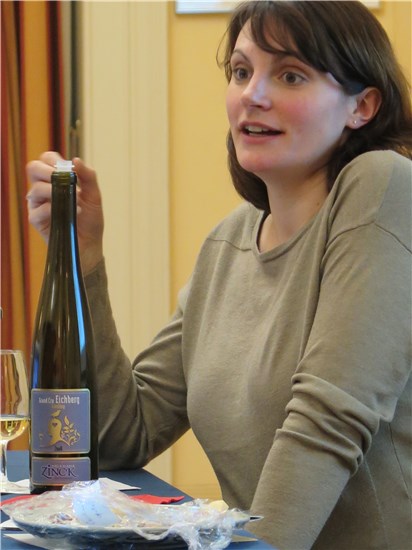 A remarkable tasting with a remarkable presenter … and some nice food too.
A remarkable tasting with a remarkable presenter … and some nice food too.
The Club was honoured to host Caroline Furstoss, native of Alsace, ‘Sommelière de l’Année’ in 2014, columnist for the Revue du Vin de France and one of the few experts on the wines of her native region. In France, Caroline explained, it’s often difficult to get the French to take the wines of Alsace seriously. All those Germanic names, all those ‘lieux-dits’ to remember. However, a full house at Lady Margaret Hall on 24 February 2016 was very receptive.
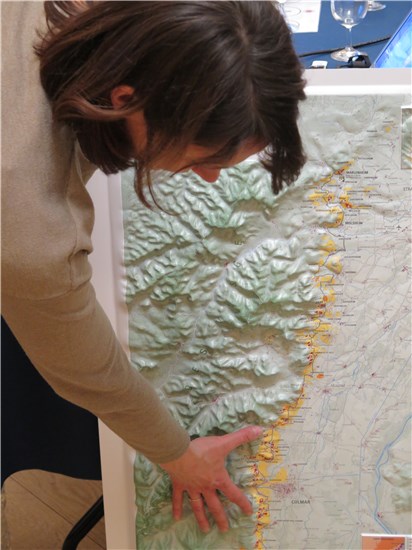 Alsace has a tiny vineyard area when compared with most appelations; just over 15,000 ha concentrated in a long thin strip running north south for around 100 km. The vineyards are on the banks of the trench in which the Rhine runs, benefiting from the long exposure to the sun on the eastern slopes of the Vosges mountains. The underlying geology is complicated but essentially similar to that of Burgundy. In other ways Alsace is unique. Along with Champagne it’s the only region where bottling must be done in the region and Alsace has its own distinctive bottle the ‘flûte d’Alsace’ (or ‘flûte rhénane’). Though there is some red made from Pinot Noir, 95% of the production is white wine based around the four Grands Crus varieties (Riesling, Muscat, Gewürztraminer and Pinot Gris) and Sylvaner.
Alsace has a tiny vineyard area when compared with most appelations; just over 15,000 ha concentrated in a long thin strip running north south for around 100 km. The vineyards are on the banks of the trench in which the Rhine runs, benefiting from the long exposure to the sun on the eastern slopes of the Vosges mountains. The underlying geology is complicated but essentially similar to that of Burgundy. In other ways Alsace is unique. Along with Champagne it’s the only region where bottling must be done in the region and Alsace has its own distinctive bottle the ‘flûte d’Alsace’ (or ‘flûte rhénane’). Though there is some red made from Pinot Noir, 95% of the production is white wine based around the four Grands Crus varieties (Riesling, Muscat, Gewürztraminer and Pinot Gris) and Sylvaner.
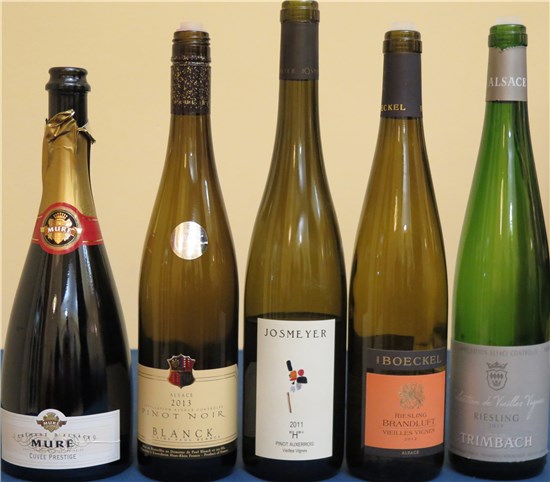 Crémant d’Alsace represents nearly 25% of the production volume and it was with a sparkling wine that Caroline opened the tasting. This was Réné Muré’s ‘Cuvée Prestige, made, like all Alsace Crémant, by méthode champenoise. The wine has a little Pinot Noir but Pinot Blanc and Auxerrois (plus Riesling and Pinot Gris) dominated this lemon gold wine with fine bubbles and aromas of white flowers, tree fruits and citrus with a touch of biscuit breadiness and good minerality. Caroline explained that the Riesling brings acidity and lemon flavours.
Crémant d’Alsace represents nearly 25% of the production volume and it was with a sparkling wine that Caroline opened the tasting. This was Réné Muré’s ‘Cuvée Prestige, made, like all Alsace Crémant, by méthode champenoise. The wine has a little Pinot Noir but Pinot Blanc and Auxerrois (plus Riesling and Pinot Gris) dominated this lemon gold wine with fine bubbles and aromas of white flowers, tree fruits and citrus with a touch of biscuit breadiness and good minerality. Caroline explained that the Riesling brings acidity and lemon flavours.
Then, in a first for the Club, a tasting of white wines started with a red. The 2013 Pinot Noir comes from the family-owned estate of Paul Blanck (the word ‘Domaine’ is the signifier). Alsatian Pinot Noirs have gradually become heavier over the last decade and some Pinot Noir is now grown on Grand Cru sites, though the full lieu-dit name can’t be used since Pinot Noir is not one of the four officially approved Grand Cru wines. The marker for this is the use of the initial of the lieu-dit rather than the full name on the label. This example had a clean, red fruit nose (cherry and kirsch perhaps) with a touch of oak. In the glass the colour was a dark ruby pale with a broad rim. On the palate most felt that the wine needed another few years of maturation before it was fully integrated.
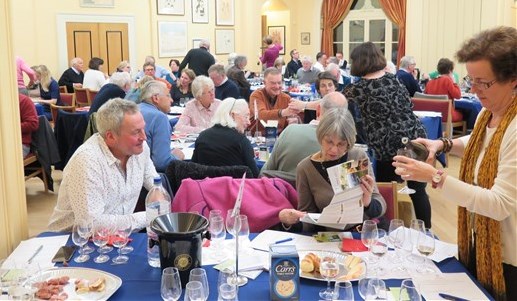 With wine number 3 we moved on to the whites. First was a 2011 Pinot Auxerrois Vieilles Vignes from Josmeyer. Pinot Auxerrrois differs from Pinot Blanc; the former gives alcohol and body, the latter acidity. Jean Josmeyer (who died this year) was devoted to Pinot Auxerrois and this wine comes from a Grand Cru site (hence the initial H for the Hengst lieu-dit). 2011 was a hot year and this wine had golden colour and relatively high levels of alcohol but, grown on limestone, it keeps its freshness well. On the nose Caroline found hawthorn flowers and hints of pineapple with stone fruit in the mouth. Lees contact makes for a rich food wine. Caroline recommended fish.
With wine number 3 we moved on to the whites. First was a 2011 Pinot Auxerrois Vieilles Vignes from Josmeyer. Pinot Auxerrrois differs from Pinot Blanc; the former gives alcohol and body, the latter acidity. Jean Josmeyer (who died this year) was devoted to Pinot Auxerrois and this wine comes from a Grand Cru site (hence the initial H for the Hengst lieu-dit). 2011 was a hot year and this wine had golden colour and relatively high levels of alcohol but, grown on limestone, it keeps its freshness well. On the nose Caroline found hawthorn flowers and hints of pineapple with stone fruit in the mouth. Lees contact makes for a rich food wine. Caroline recommended fish.
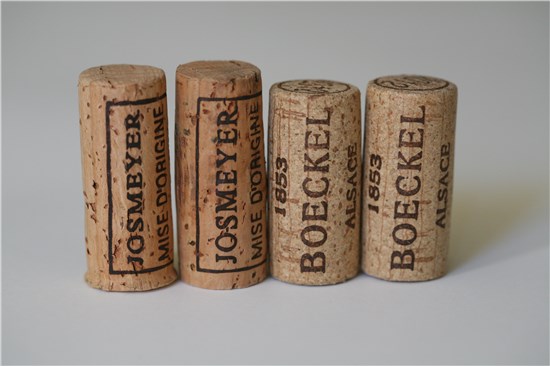 Wines 4, 5 and 6 were all Riesling, starting with Emile Boeckel’s ‘lieu-dit Brandluft’ from 2012, moving on to a Trimbach Vieilles Vignes of 2011 and finishing with a 2009 Domaine Zinck Eichberg Grand Cru. 2012 was less hot than 2011 or 2009. Though each has a different soil mix, limestone was a common element, giving acidity and freshness to each wine, which were otherwise different in style. The Emile Boeckel (many members’ favourite from the evening) was paler in colour, less intense on the nose and with elegant lemon and grapefruit aromas. A wine for crab with avocado or salmon perhaps.
Wines 4, 5 and 6 were all Riesling, starting with Emile Boeckel’s ‘lieu-dit Brandluft’ from 2012, moving on to a Trimbach Vieilles Vignes of 2011 and finishing with a 2009 Domaine Zinck Eichberg Grand Cru. 2012 was less hot than 2011 or 2009. Though each has a different soil mix, limestone was a common element, giving acidity and freshness to each wine, which were otherwise different in style. The Emile Boeckel (many members’ favourite from the evening) was paler in colour, less intense on the nose and with elegant lemon and grapefruit aromas. A wine for crab with avocado or salmon perhaps.
The Trimbach 2011 was richer in colour and an initially rather closed nose, though lemon and iodine were noticeable as the wine opened up. This is a very dry wine (a rather austere ‘Protestant’ style, said Caroline) that takes time to come round but has a long life ahead of it. The Domaine Zinck wine was yet more gold in colour with a distinctly honeyed nose and a range of yellow fruit (peach, pineapple). There was a good deal of residual sugar (perhaps 12-15 grams per litre) which meant it would pair well with spiced foods. This is another wine made for longevity; perhaps five years to open up and a few more for the sugar and acidity to come into full balance. The issue of labelling wines to indicate the level of sugar is a vexed one in Alsace. They tried a few years ago to create a scale similar to that used in Austria but this hasn’t worked. At the moment it’s really a question of know your producer!
In response to question on the kerosene flavour often found in Riesling, Caroline suggested that in Alsace it might be linked to high yields (rather than the schistous soil that contributes to its presence in German wines).
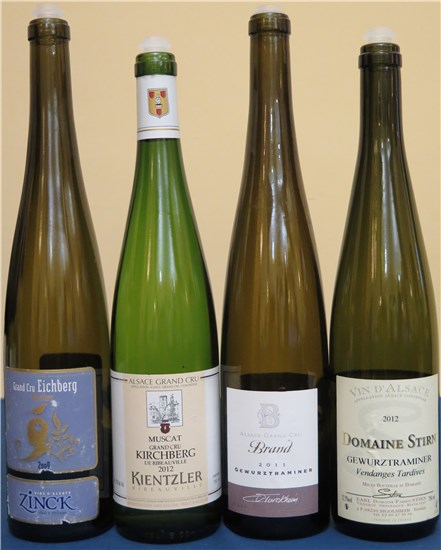 Wine no 7 was a 2012 Grand Cru Muscat from Kientzler’s Kirchberg de Ribeauville. This particular wine has more of the pinker-skinned Muscat d’Ottonel than Muscat d’Alsace and this was reflected in the faintly pink notes in the colour of the wine. On the nose it had a linear purity with hints of peppermint and spice and citrus; in the mouth it was drier than we had expected (definitely an aperitif wine). Muscat is sensitive to rot and disease and a wine as dry as this is rare in Alsace.
Wine no 7 was a 2012 Grand Cru Muscat from Kientzler’s Kirchberg de Ribeauville. This particular wine has more of the pinker-skinned Muscat d’Ottonel than Muscat d’Alsace and this was reflected in the faintly pink notes in the colour of the wine. On the nose it had a linear purity with hints of peppermint and spice and citrus; in the mouth it was drier than we had expected (definitely an aperitif wine). Muscat is sensitive to rot and disease and a wine as dry as this is rare in Alsace.
The final two wines were both Gewürztraminers. The first was a 2011 Grand Cru from Cave de Turckheim (the highly rated co-operative); the second a 2012 Vendanges Tardives from Domaine Stirn. Gewurztraminer is less susceptible to soil influence than Riesling and the growers need to be careful about yields. Left too long, the grapes pick up too much sugar in a very short space of time.
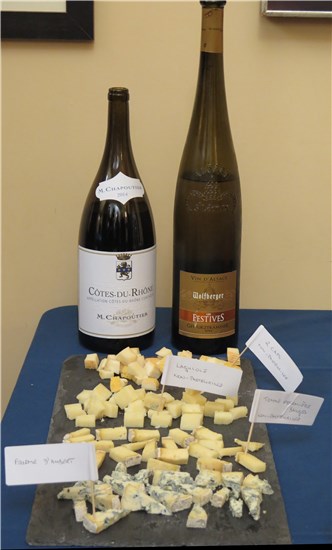 The Turckheim wine was a light gold in colour with pink notes and rich aromas of spice, lychees, roses and geraniums with a pleasing note of bitterness and pink peppercorn in the mouth. The Vendanges Tardives from Stirn was very different: more golden in colour, botrytis on the nose but still a scent of roses. High in residual sugar (perhaps 200 grams per litre) this was a brilliant example of a late harvest wine.
The Turckheim wine was a light gold in colour with pink notes and rich aromas of spice, lychees, roses and geraniums with a pleasing note of bitterness and pink peppercorn in the mouth. The Vendanges Tardives from Stirn was very different: more golden in colour, botrytis on the nose but still a scent of roses. High in residual sugar (perhaps 200 grams per litre) this was a brilliant example of a late harvest wine.
Eagerly questioned about where to find Alsace wines, Caroline suggested Le Grand Restaurant on the Champs-Elysée in Paris (www.jeanfrancoispiege.com/fr) and Les 110 de Taillevent (110 wines by the glass) in their wine shop in Cavendish Square in London (www.les-110-taillevent-london.com/en).
We have to thank not only the Alsace Marketing Board for donating most of the wines (and Caroline for persuading them to be so generous) but also Chris Blakey of the Club who put a great deal of effort into sourcing the food (charcuterie, cheese and breads) and providing a wonderful range of cheeses and magnums of red and white wine for members to enjoy after the tasting.
‘Keep Calm and #DrinkAlsace’ was the final message from Caroline. After such a performance how could we not?
GH: 27/2/16